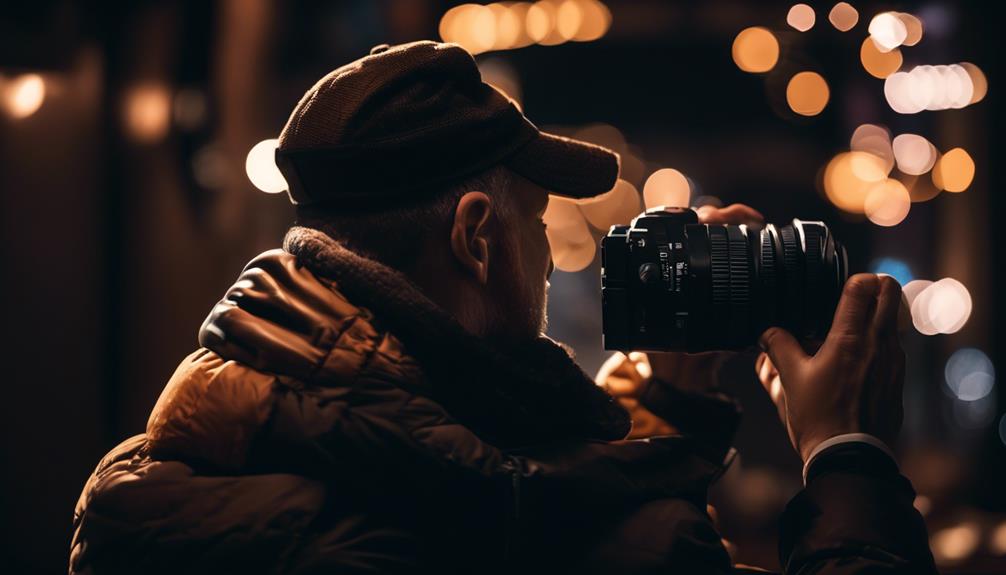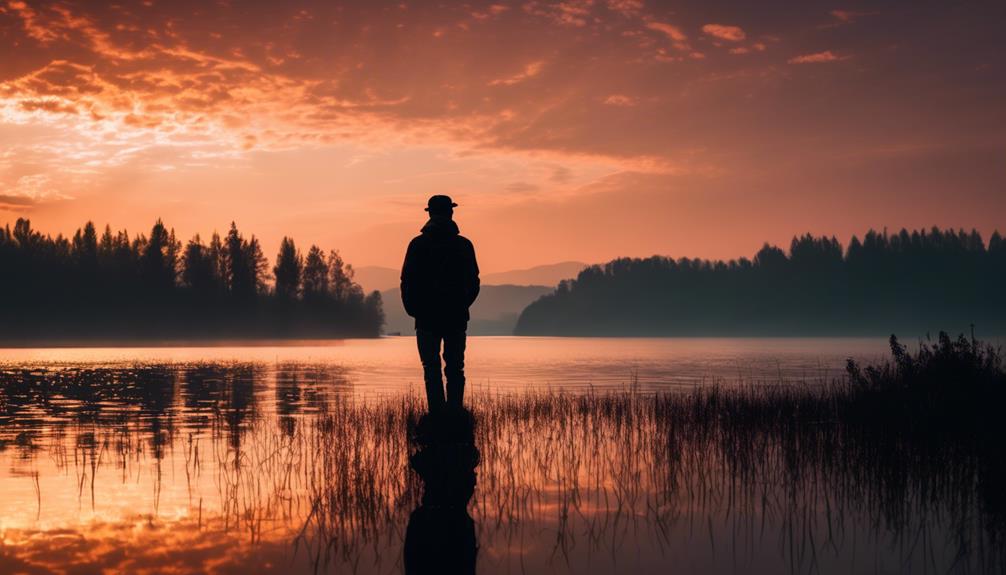Please note this post may contain affiliate links picked by me (Jay) that I have deemed may be of interest or relevant to you the reader of this.
These links do not affect the cost of the thing if you decide to purchase but i may get a little money if you choose to purchase.
For more information on my affiliate link policy click here.
As I pick up my camera and venture into the world of photography, I realize that it is not just about capturing beautiful images; it is about navigating a complex landscape of ethical concerns. From understanding consent and privacy issues to respecting cultural sensitivities, there are crucial considerations that every photographer must keep in mind.
So, how can we ensure that our photography is not only inspiring but also ethically responsible? In this discussion, I will share five valuable tips that address these ethical concerns and help us become more conscious and responsible photographers.
Get ready to unlock the secrets of ethical photography and capture the world in a way that respects and uplifts everyone involved.
Key Takeaways
- Informed consent is crucial in photography, especially when photographing sensitive situations or minors.
- Building relationships and establishing trust with the communities you photograph can help avoid exploitation and appropriation.
- Respecting cultural sensitivities and avoiding stereotypes is important for authentic and respectful representations.
- Transparency and balancing artistic expression with ethical responsibility are essential when navigating the ethics of photo manipulation.
Understanding Consent and Privacy Issues
Understanding the importance of consent and privacy issues is crucial for ethical photographers like myself. In the fast-paced world of photography, where innovation and creativity are highly valued, it's essential to ensure that we respect the rights and boundaries of our subjects. Informed consent is the foundation of ethical photography. It means that individuals understand and agree to be photographed, and they're fully aware of how their images will be used. As photographers, we've a responsibility to obtain consent before capturing someone's image, especially in sensitive situations or when photographing minors.
Legal boundaries also play a significant role in ethical photography. Each country has its own laws regarding privacy and photography, and it's essential to familiarize ourselves with these regulations to avoid any legal issues. For example, in some places, it may be illegal to photograph certain buildings or landmarks without permission. By understanding and respecting these legal boundaries, we can ensure that our photography practices remain ethical and lawful.
Avoiding Exploitation and Appropriation
To ensure ethical photography practices, it's vital to navigate the complex terrain of avoiding exploitation and appropriation. In the pursuit of informed inspiration, it's important to establish clear ethical boundaries that respect the subjects of our photographs and the cultures from which they originate.
Exploitation occurs when we take advantage of vulnerable individuals or communities for our own gain, while appropriation happens when we borrow elements from a culture without proper understanding or respect. As photographers, we must be mindful of these issues and strive to create work that's both innovative and ethically responsible.
One way to avoid exploitation and appropriation is to establish relationships with the communities we photograph. By building trust and open communication, we can ensure that our intentions are understood and that we aren't taking advantage of anyone. It's also important to do thorough research and educate ourselves about the cultures we're representing. This allows us to approach our work with sensitivity and respect, avoiding the misrepresentation or distortion of traditions and customs.
Furthermore, seeking permission and obtaining consent from our subjects is crucial. We must always respect their autonomy and ensure that they're comfortable with their likeness being captured and shared. This involves open dialogue and clear communication about the purpose and use of the photographs.
Respecting Cultural Sensitivities
Respecting cultural sensitivities is essential in photography to ensure that we honor and appreciate the diverse traditions and customs of the communities we photograph. It's our responsibility as photographers to approach different cultures with cultural appreciation and respect, while also being aware of the ethical boundaries that exist.
To achieve this, here are three important steps to consider:
- Educate yourself: Before embarking on a photography project that involves a different culture, take the time to learn about their customs, traditions, and values. Understanding the cultural context will help you navigate the ethical considerations and avoid unintentional disrespect.
- Seek permission and build relationships: Building trust and establishing relationships with the communities you photograph is crucial. Communicate your intentions clearly and seek permission before capturing their images. By involving them in the process, you ensure that their voices are heard and that they have agency over their representation.
- Avoid stereotypes and exploitation: Be mindful of the images you capture and how they may perpetuate stereotypes or exploit the culture you're documenting. Strive for authentic and respectful representations that challenge preconceived notions and showcase the true diversity and richness of the culture.
Navigating the Ethics of Photo Manipulation
Navigating the ethics of photo manipulation requires careful consideration and a commitment to maintaining the integrity of the captured image. In an age where technology allows us to manipulate photos with ease, it's important to understand the ethical implications of these manipulation techniques.
Photo manipulation refers to altering or enhancing an image digitally, often using software like Photoshop. While it can be tempting to use these techniques to create stunning and visually captivating images, it's crucial to remember that photo manipulation can have ethical implications.
One ethical concern is the potential for misrepresentation. When we manipulate a photo, we've the power to change the reality it portrays. This raises questions about authenticity and truthfulness in photography. Is it fair to manipulate an image to the point where it no longer accurately represents the subject or the event it captures?
Another ethical consideration is the impact of photo manipulation on the viewer. Manipulated images can create unrealistic expectations and perpetuate harmful stereotypes. This can have serious consequences, especially in the context of advertising and media where manipulated images are often used to sell products or shape public opinion.
To navigate the ethics of photo manipulation, it's important to be transparent about any alterations made to an image. By clearly indicating that a photo has been digitally manipulated, viewers can make informed judgments about its authenticity and interpretive value.
Ultimately, the key is to strike a balance between artistic expression and ethical responsibility. By being mindful of the ethical implications of our manipulation techniques, we can ensure that our photographs remain true to their original intent while still pushing the boundaries of innovation.
Promoting Responsible Representation
Promoting responsible representation in photography is essential for ensuring that images accurately and ethically portray their subjects. As photographers, we have a responsibility to tell stories in a way that is respectful and authentic.
Here are three key ways to promote responsible representation in your photography:
- Embrace ethical storytelling: When capturing images, it is important to consider the impact they may have on the subjects and the wider audience. Take the time to understand the cultural and social context of the people you are photographing, and aim to capture their stories in an honest and respectful manner. Avoid exploiting or sensationalizing their experiences for personal gain.
- Seek authentic representation: In the pursuit of diversity and inclusivity, it is crucial to ensure that the subjects in our photographs are represented accurately. Avoid perpetuating stereotypes or reinforcing biased narratives. Instead, strive to capture the true essence of individuals and communities, showcasing their diversity and uniqueness.
- Collaborate and involve the community: To promote responsible representation, actively involve the subjects in the photographic process. Seek their consent, listen to their stories, and include their perspectives in the storytelling process. This collaborative approach not only ensures authenticity but also empowers the individuals being photographed.
Frequently Asked Questions
How Can I Ensure That I Have Obtained Proper Consent From My Subjects Before Taking Their Photographs?
To ensure I've obtained proper consent from my subjects before taking their photographs, I always prioritize privacy protection.
It's crucial to respect the rights and dignity of the individuals I photograph. Before capturing their image, I make sure to explain my intentions, seek their permission, and address any concerns they may have.
This way, I establish a trusting relationship and ensure that I'm ethically and responsibly capturing moments of inspiration through my lens.
What Measures Can I Take to Protect the Privacy of Individuals Featured in My Photographs?
To protect the privacy of individuals featured in my photographs, I take several measures.
First and foremost, I always ensure that I've obtained proper consent from my subjects before taking their photographs. This involves clearly explaining how the images will be used and obtaining their written consent.
Additionally, I take great care in not revealing any identifying information about the individuals in my photographs, such as their names or personal details. Respecting their privacy is of utmost importance to me.
How Can I Avoid Exploiting or Appropriating the Cultures or Traditions of the Subjects I Photograph?
When photographing different cultures and traditions, it's crucial to understand the thin line between cultural appreciation and cultural appropriation.
To avoid exploiting or appropriating, I always prioritize ethical considerations. I research and educate myself about the cultural significance of the subjects I photograph, ensuring I approach sacred rituals with respect and sensitivity.
Are There Any Specific Cultural Sensitivities I Should Be Aware of When Photographing People From Different Backgrounds?
When photographing people from different backgrounds, it's crucial to be aware of cultural sensitivities. Respecting and representing their culture in a respectful manner should be the top priority. Understanding their traditions, customs, and values can help avoid unintended offense or appropriation.
What Are the Ethical Boundaries When It Comes to Manipulating Photographs, and How Can I Navigate Them Responsibly?
When it comes to manipulating photographs, understanding the ethical implications is crucial. As a photographer, I navigate these boundaries responsibly by ensuring that any digital manipulation is done transparently and with respect for the subject matter.
This means being truthful about any alterations made and considering the impact it may have on the audience's perception. By embracing innovation and staying informed about ethical guidelines, I can push the boundaries of creativity while maintaining integrity in my work.
Conclusion
In conclusion, ethical concerns in photography should never be taken lightly. By understanding consent and privacy issues, avoiding exploitation and appropriation, respecting cultural sensitivities, navigating the ethics of photo manipulation, and promoting responsible representation, photographers can ensure that their work is both ethically sound and enjoyable for all.
So, the next time you pick up your camera, remember that capturing the perfect shot goes hand in hand with upholding strong ethical values. Stay inspired, stay ethical, and keep snapping those incredible moments!

